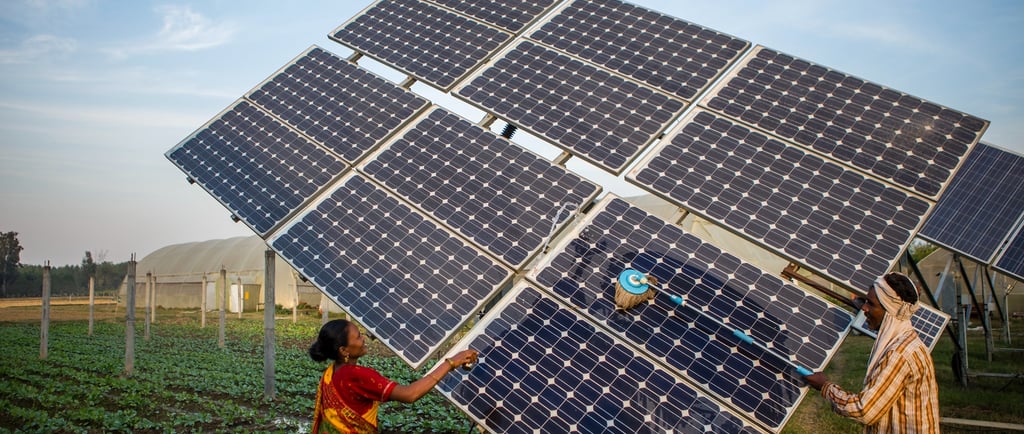India: Energy Challenges and Diversification
India is addressing its energy challenges by diversifying its energy mix and expanding the use of natural gas and electric vehicles. How will this ambitious transition impact its economy and create opportunities for global and domestic industries?
INDIA
Aisulu Sarmanova
11/18/20244 min read


India is taking action to address its energy shortage. The energy demand of the nation is anticipated to increase as its population, already the largest in the world, continues to expand and its affluence grows. It is therefore unsurprising that the South Asian nation intends to quadruple its natural gas consumption from its current level by 2030 in order to satisfy this demand and facilitate annual GDP growth rates of seven to eight percent.
India has led global growth for the past twenty years and will continue to be a significant contributor to the world's development in the forthcoming decades. The availability of appropriate electricity at a competitive price has been fundamental to India's economic narrative. Given the markedly low per capita energy use and the objective of guaranteeing dependable coverage and availability nationwide, the nation's emphasis has consistently been on establishing an energy framework that is safe, secure, sustainable, and affordably accessible at all times. The Government of India is striving to elevate the proportion of natural gas, an optimal transition fuel, in the nation's primary energy mix from about 6% to 15% by the conclusion of 2030, thereby transforming India into a gas-based economy. This is anticipated to lift India's gas consumption by over 200%.
The recent shift of attention back to gas is connected to the political agenda India pursues in the environmentally friendly market. A forceful initiative to promote electric vehicles was underway in India. In 2022, the electric vehicle (EV) market in India had expanded rapidly, with over a million vehicles on the road. The Indian government has established an ambitious plan, with the objective of replacing 30% of all vehicles on the road with electric vehicles by 2030. The National Electric Mobility Mission Plan (NEMMP) and the Faster Adoption and Manufacturing of Hybrid and Electric Vehicles (FAME) scheme are among the initiatives that were supporting this objective. The purpose of these initiatives was to encourage the usage of electric vehicles and to promote their domestic production. The Indian government's policies encompassed monetary assistance, subsidies, and tax incentives for both consumers and manufacturers. The objective of this strategy was to decrease the nation's reliance on imported petroleum oil and foster the expansion of the domestic electric vehicle industry. In addition, the transition to electric mobility was being expedited by private companies in India. The EV sector was projected to generate approximately 5 crore (50 million) new jobs, representing a substantial opportunity for India's expanding workforce. To facilitate this expansion, organisations were constructing new manufacturing facilities, expanding their electric vehicle offerings, and investing in research and development.
However, recent changes to the policy show a slightly different pattern. The Indian government has implemented policies that prioritise vehicles operating on compressed natural gas (CNG), a derivative of liquefied natural gas (LNG). As a result of a robust petroleum distribution network, range anxiety has diminished, resulting in quicker adoption of these vehicles than electric vehicles. It is also generally less expensive to operate them on a per-mile basis. This has resulted in a 33% increase in sales this year, reaching over half a million vehicles. Additionally, the government announced earlier this year that it intends to transition one-third of the nation's heavy-duty vehicles to LNG in lieu of diesel, which currently constitutes the majority of refined fuel, within the next five to seven years. In addition to transportation, the utilisation of LNG has increased as a result of government policies that promote the use of natural gas for domestic cooking. According to the Institute for Energy Economics and Financial Analysis, the number of piped connections has increased by 250% in the seven years ending in November 2023. In the interim, the number of households that have the potential to receive channelled natural gas exceeds 300 million.
India's initiatives to expand its electric vehicle (EV) and natural gas industries generate an extensive array of business opportunities. India's objective is to transition from coal to natural gas and to increase its natural gas consumption to 15% by 2030. This necessitates the construction of substantial gas infrastructure. This may involve the construction of storage facilities, LNG import terminals, and pipelines. This would enable foreign companies that specialise in energy engineering, infrastructure, and technology to conduct business in the region. In addition, the government's emphasis on CNG and LNG vehicles creates opportunities for both domestic and foreign companies that concentrate on the production of parts, gas stations, and retrofitting services.
Additionally, the rapid proliferation of electric vehicles (EVs) as a result of policies such as NEMMP and FAME opens up opportunities for companies that manufacture EVs, batteries, and charging infrastructure, both domestically and internationally. There is an opportunity for partnerships to contribute to the expansion of the workforce, particularly in the areas of teaching and upskilling workers in the production and maintenance of electric vehicles, given the anticipated 50 million jobs in this sector.
The utilisation of channelled natural gas for cookery has increased in the domestic sector, indicating that there is potential for growth in the production of household equipment, particularly those that operate with gas. India's emphasis on the availability and affordability of energy, in conjunction with this demand, has resulted in partnerships and investments that assist the government in achieving its energy objectives and provide the companies engaged with a broader market access.
The modifications to India's energy strategy demonstrate that there are substantial opportunities for businesses across all sectors. Not only can companies that support India's sustainable energy objectives contribute to the country's growth, but they can also establish long-term relationships and access new markets, thereby fostering innovation, infrastructure development, and the availability of energy for millions of individuals.


